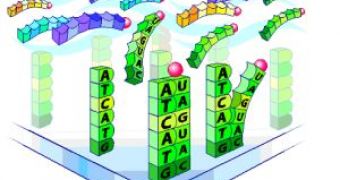Fluorescence is now widely used in genetic researches for tagging DNA.
Now, a new approach at Carnegie Mellon University could boost this technology for fluorescence-based imaging and medical diagnosis.
The sensitivity of the technique was greatly increased by connecting bright fluorescent dye molecules with DNA nanostructure templates to generate nanosized fluorescent labels, important in assessing chemical and biochemical reactions in single molecules or cells. "Our DNA nanotags offer unprecedented densities of fluorescent dyes and, thus, the potential for extremely bright fluorescent labels," said graduate student Andrea Benvin.
"We've put it all into a very small package, which will allow us to detect molecules with great sensitivity without interfering with the biological processes we are trying to understand."
"The high brightness of the nanotags should be of great help in detecting rare cancer cells within tissue biopsies, for example, which is important in determining whether treatments have been successful or if recurrence is likely," said Bruce Armitage, associate professor of chemistry in the Mellon College of Science (MCS).
"In addition, DNA nanotags offer the opportunity to perform multicolor experiments. This feature is extremely useful for imaging applications, because the multiple colors can be seen simultaneously, requiring only one experiment using one laser and one fluorescence-imaging machine", said Armitage. "For example, two different populations of cells, one healthy and the other cancerous, could be distinguished based on labeling them with different color fluorescent nanotags," Armitage said.
The team created their DNA nanotags based on the structure of phycobiliproteins, algal fluorescent pigments employed in photosynthesis. "The primary advantages of our system are the simplicity of its design combined with the ease with which the fluorescence brightness and color can be tuned," Armitage said.
The team assembled well-defined nanostructured DNA templates that bind multiple fluorescent dye molecules between base pairs in the DNA helix in an arrangement that maintains dyes far enough away from each other to impede canceling out each other's fluorescence, with the result of an improved brightness.
The DNA templates can also be adjusted to other molecules or to the membrane of a targeted cell.
The innovative design creates nanotags with large light-harvesting capabilities and very high light-emission (fluorescence) intensities. The DNA molecule binds one dye molecule for every two base pairs, thus a 30-base pairs DNA nanostructure can attach to 15 fluorescent dye molecules, being 15 times brighter than an individual dye molecule. And the more base pairs in the DNA nanostructure, the more brightness.
As the DNA nanotags possess "light-harvesting" dyes within the DNA helix that are excited by one wavelength of light and then transmit that excitation energy to "light-emitting" dyes on the nanotag's surface, the dyes can fluoresce at a different color from the light-harvesting dye.
For example, if one type of DNA nanotag harvests blue light and transmits that light energy to another dye within the nanostructure, the second one could emit orange, red or even infrared light. "Changing the light-harvesting dyes allows even more variation in the fluorescence color," Armitage said.
The researchers warn that the rapidly growing field of DNA nanotechnology is developing increasingly intricate three-dimensional nanostructures that would revolutionize this technique. "We really feel that this is the tip of the iceberg and that nanotags 100 times brighter than existing labels can be developed in any color," he said.

 14 DAY TRIAL //
14 DAY TRIAL //